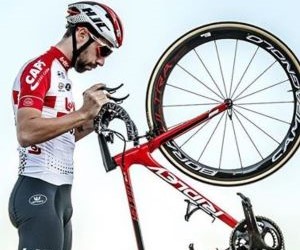Learn how to deal with punctures on long rides with prevention tips, repair techniques, and smart gear choices to keep rolling without stress.
HOW DO I IMPROVE EFFICIENCY IN GROUP RIDES?
Cycling in groups is both social and strategic. Done right, it maximizes efficiency, conserves energy, and elevates the pace for everyone. Done wrong, it becomes chaotic, tiring, and even dangerous. The difference lies in knowing how to ride smoothly with others: mastering drafting techniques, rotating through pacelines, and communicating effectively. This article explores proven tactics to help cyclists—from weekend enthusiasts to competitive racers—improve efficiency in group rides, ensuring faster speeds, safer conditions, and a stronger collective rhythm.

Mastering the art of drafting
Drafting is the backbone of group riding efficiency. By riding in another cyclist’s slipstream, you can reduce wind resistance by up to 30%, conserving energy for later stages of the ride. But drafting effectively is about more than just sitting behind a wheel—it requires precision, trust, and awareness of the group’s rhythm.
Finding the sweet spot
The ideal drafting position is typically 6–12 inches behind the wheel in front. Too close, and you risk collisions; too far, and you lose the aerodynamic benefit. Side winds complicate this, requiring a staggered “echelon” formation where riders overlap wheels diagonally to maintain shelter.
Common drafting mistakes
New riders often surge or brake too frequently, disrupting the flow. Smoothness is critical: hold a steady pace, anticipate shifts, and use soft pedaling or light braking instead of abrupt moves. Riders should also avoid “half-wheeling,” where overlapping the rider ahead increases crash risk.
Maintain 6–12 inches gap for optimal drafting.
Adjust position in side winds using echelons.
Stay smooth to avoid unnecessary accelerations.
Never overlap wheels; it’s the quickest way to crash.
Drafting mastery transforms rides, conserving energy for climbs, sprints, or long distances. Experienced riders often describe it as “free speed,” but it only works when every cyclist respects spacing and rhythm.
Efficient rotations and pacelines
Group efficiency depends on how riders share the workload. Pacelines—organized rotations at the front—are the engine of smooth, fast group rides. Executed properly, they allow every rider to contribute while resting in the draft when not leading. There are several paceline styles, each suited to different terrain and group sizes.
Single and double pacelines
In a single paceline, one rider leads while others follow in a line. The leader peels off after a set time or distance, drifting to the back. In a double paceline, two riders lead side by side, creating two drafting lines behind them. Double pacelines are ideal for larger groups and steady terrain, while singles suit narrower roads or smaller packs.
The rotating paceline
A rotating paceline is a dynamic version where riders continuously rotate forward on one side and drift back on the other, like a conveyor belt. This method maintains high speeds and equal workload distribution but requires strong coordination and discipline.
Single paceline: best for narrow roads or small groups.
Double paceline: adds stability and shared effort.
Rotating paceline: maximizes speed and efficiency in experienced groups.
Leaders should pull for 30–60 seconds, depending on strength and terrain.
Pacelines epitomize teamwork. When everyone rotates smoothly, energy savings compound, allowing the group to cover long distances faster and with less fatigue.
Communication and group etiquette
Even the strongest paceline collapses without good communication. Signals, calls, and etiquette keep the group safe and efficient. Verbal cues warn of hazards, while hand signals communicate intentions like stopping, slowing, or obstacles ahead. Clear communication reduces crashes and maintains flow.
Essential signals and calls
Pointing down indicates potholes or debris, while a raised hand signals slowing or stopping. Shouting “car back” alerts riders to vehicles approaching from behind. The leader has the responsibility to call out hazards and set a steady pace, while those behind relay information forward.
Etiquette that drives efficiency
Courtesy is not optional in group riding. Riders should avoid sudden accelerations, hogging the front, or weaving unpredictably. Consistency builds trust, and trust makes drafting and pacelines more effective. Groups that ride with discipline not only go faster but also attract more riders to join their rides.
Use clear hand signals and verbal calls.
Leaders should maintain steady pacing and alert others to hazards.
Avoid erratic movements to preserve group flow.
Respect rotations and share the workload fairly.
Efficient group rides aren’t just about speed—they’re about collective rhythm. Communication and etiquette ensure that every rider feels safe and valued, allowing the group to perform at its peak.
YOU MAY ALSO BE INTERESTED






